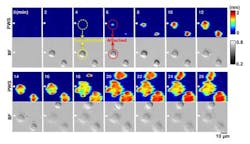Enhanced label-free microscope tracks cell adhesion in high resolution
A team of researchers at the University of Illinois at Urbana-Champaign's College of Engineering (Urbana, IL) has developed a microscope that can image living cells in a way that could someday help biologists better understand how stem cells transform into specialized cells and how diseases like cancer spread.
Related: Label-free microscopy method is promising for more accurate cancer diagnosis, prognosis
The team's photonic-crystal enhanced microscope (PCEM) can monitor and quantitatively measure cell adhesion, a critical process involving cell migration, cell differentiation, cell division, and cell death. The work was done in the Micro + Nanotechnology Lab, which is led by Brian Cunningham, the Donald Biggar Willett Professor of Engineering.
Most conventional imaging methods rely on fluorescent dyes, which attach to and illuminate the cell components so they are visible under a microscope. However, fluorescent tagging is invasive, difficult for quantitative measurement, and only provides a short-term window of time for cell examination and measurement because of photobleaching.
Yue Zhuo, a postdoctoral Beckman Institute Fellow who led the work, says that fluorescent tagging doesn't allow scientists to see how a protein or cell changes over time. "You can see the cell for maybe a few hours maximum before the fluorescent light dies out, but it takes several days to conduct a stem cell experiment," Zhuo says. "Scientists commonly use fluorescent tagging because there's no better way to monitor live cells due to their low imaging contrast among cellular organelles. That urges us to develop a label-free and high-resolution imaging method for live cell study."
The research team's microscope functions with an LED light source and a photonic-crystal biosensor made from inexpensive materials like titanium dioxide and plastic using a fabrication method like nanoreplica molding. Zhuo explains that the sensor is easily mass-producible, and costs less than $1 each to make.
In Zhuo's apparatus, the photonic-crystal biosensor is an optical sensor that can apply to any attachable cells. The sensor surface is coated with extracellular matrix materials to facilitate cellular interactions, which are then viewed through a normal objective lens and recorded with a CCD camera.
"The advantage of our PCEM system is you can see as the [live] cell is beginning to attach to our sensor, and we can quantitatively and dynamically measure what happened at that time," Zhuo says. "We’re able to actually measure a very thin layer on the bottom of the cell that's about 100 nm, which is beyond the diffraction limit for visible light."
By using the PCEM, Zhuo has successfully measured the effective mass density of cell membranes during stem cell differentiation, and cancer cell response to drugs in an extended period.
In the future, Zhuo plans to outfit the microscope with higher imaging resolution and someday hopes to be able to build a library of cell adhesion data for scientists. "Different types of cells will have different dynamic attachment profiles," she explains. "We can use this library to screen different types of cells for tissue regeneration, disease diagnostic, or drug treatment, for example, to see how diseased cells spread, or see how the cancer cells respond to different drug treatment."
Full details of the work appear in the journal Progress in Quantum Electronics; for more information, please visit http://dx.doi.org/10.1016/j.pquantelec.2016.10.001.



